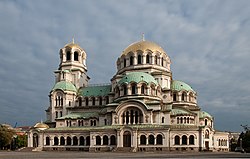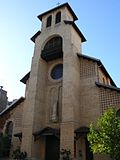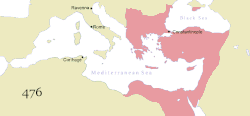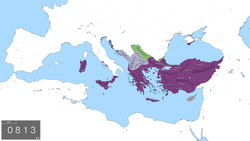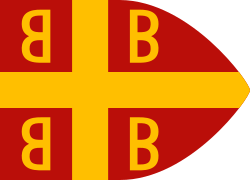Neo-Byzantine architecture (also referred to as Byzantine Revival) was a revival movement, most frequently seen in religious, institutional and public...
24 KB (2,343 words) - 05:52, 15 February 2025
Byzantine architecture is the architecture of the Byzantine Empire, or Eastern Roman Empire, usually dated from 330 AD, when Constantine the Great established...
39 KB (4,334 words) - 03:28, 17 May 2025
to the Byzantine architecture, called the Neo-Byzantine style. Russian-Byzantine style became an officially endorsed preferred architectural style for...
69 KB (4,759 words) - 12:33, 5 June 2025
Russian architecture that arose in the second quarter of the 19th century and was an eclectic melding of Byzantine elements (Neo-Byzantine architecture in...
21 KB (1,892 words) - 13:45, 2 November 2024
Serbo-Byzantine architectural style, Neo-Byzantine architectural style or Serbian national architectural style is the style in Serbian architecture which...
8 KB (927 words) - 15:39, 24 February 2025
Nazi architecture 1933–1944 Germany Neo-Byzantine architecture 1882–1920s American Neoclassical architecture Neo-Grec 1848–1865 Neo-Gothic architecture Neolithic...
48 KB (2,926 words) - 09:33, 16 June 2025
Post-Byzantine era (16th-18th c.) Modern church buildings belonging to the Byzantine Revival architecture also known as Neo-Byzantine architectural style...
1,006 bytes (141 words) - 11:58, 16 November 2023
Pierre Sardou in a combnation of the styles of neo-classical architecture and neo-Byzantine architecture, a blend very popular in that period. In 1919...
7 KB (717 words) - 11:18, 23 April 2025
influenced by the Byzantine art tradition. The architectural school was also promoted as a counter to the dominance of Western styles such as Neo-Baroque. The...
5 KB (499 words) - 19:08, 9 September 2022
Bristol Byzantine is a variety of Byzantine Revival architecture that was popular in the city of Bristol from about 1850 to 1880. Many buildings in the...
6 KB (549 words) - 17:11, 28 June 2024
the 15th century. Byzantine may also refer to: Byzantine architecture Byzantine Revival architecture, a.k.a. Neo-Byzantine architecture, an historicist...
2 KB (230 words) - 05:37, 22 September 2024
Revival architecture and Neo-Grec (revivals of Ancient Greek architecture) Byzantine Revival architecture (revival of Byzantine architecture) Bristol...
11 KB (1,007 words) - 10:34, 18 February 2025
Roman usurpers List of Byzantine usurpers Succession to the Byzantine Empire List of Roman and Byzantine empresses List of Byzantine emperors of Armenian...
113 KB (3,467 words) - 23:13, 15 June 2025
Byzantine romance represents a revival of the ancient Greek romance of Roman times. Works in this category were written by Byzantine Greeks of the Eastern...
6 KB (636 words) - 23:16, 29 October 2023
Byzantine Italy consisted of various parts of the Italian peninsula that were under the control of the Byzantine Empire since the Gothic War (535–554)...
5 KB (400 words) - 20:32, 13 June 2025
the junction of Berkley Street and Princes Road. Built in the Neo-Byzantine architecture style, it was completed in 1870. The architects were W. & J. Hay...
3 KB (331 words) - 11:16, 11 May 2025
begun in 1937 but not completed until 1957. It is an example of [Neo-Byzantine architecture]. The first church on the site was built between 1842 and 1845...
8 KB (705 words) - 15:33, 31 March 2025
term Byzantine commonwealth was coined by 20th-century historian Dimitri Obolensky to refer to the area where Byzantine general influence (Byzantine liturgical...
7 KB (687 words) - 13:41, 1 June 2025
Byzantine Dark Ages is a historiographical term for the period in the history of the Eastern Roman (Byzantine) Empire, from around c. 630 to the 760s...
11 KB (1,328 words) - 05:23, 5 May 2025
of Neo-Byzantine architecture are present in buildings such as Vuk Foundation House, the Old Post Office in Kosovska street, and sacral architecture, such...
29 KB (2,528 words) - 16:33, 24 February 2025
Byzantine and Post-Byzantine Musical Instruments Museum of Byzantine Culture Neo-Byzantine architecture in the Russian Empire Norman-Arab-Byzantine culture...
17 KB (1,541 words) - 22:31, 13 February 2025
The Byzantine senate or Eastern Roman senate (Greek: Σύγκλητος, Synklētos, or Γερουσία, Gerousia) was a continuation of the Roman Senate, established...
14 KB (1,829 words) - 15:52, 10 June 2025
Nikephorian dynasty of the Byzantine Empire began following the deposition of the Empress Irene of Athens. The throne of the Byzantine Empire passed to a relatively...
6 KB (352 words) - 08:30, 17 April 2025
New Classical architecture, also known as New Classicism or Contemporary Classical architecture, is a contemporary movement that builds upon the principles...
31 KB (2,761 words) - 00:13, 9 June 2025
The Byzantine army was the primary military body of the Byzantine armed forces, serving alongside the Byzantine navy. A direct continuation of the Eastern...
106 KB (13,711 words) - 05:27, 2 June 2025
Subdivisions of the Byzantine Empire were administrative units of the Eastern Roman or Byzantine Empire (330–1453). The Empire had a developed administrative...
13 KB (1,282 words) - 20:55, 29 April 2025
Obrechtkerk (category Neo-Byzantine architecture)
was followed by both architects at the time. It's a church built in Neo-Byzantine and Romanesque Revival style with a front-side that faces east, flanked...
5 KB (319 words) - 15:37, 6 November 2024
Byzantine currency, money used in the Eastern Roman Empire after the fall of the West, consisted of mainly two types of coins: gold solidi and hyperpyra...
19 KB (1,976 words) - 16:58, 19 September 2024
The Byzantine Empire under the Macedonian dynasty underwent a revival during the late 9th, 10th, and early 11th centuries. Under the Macedonian emperors...
19 KB (1,796 words) - 21:37, 2 June 2025
The Amorian dynasty (or Phrygian dynasty) ruled the Byzantine Empire from 820 to 867. The Amorian dynasty continued the policy of restored iconoclasm...
10 KB (773 words) - 18:38, 22 July 2024

